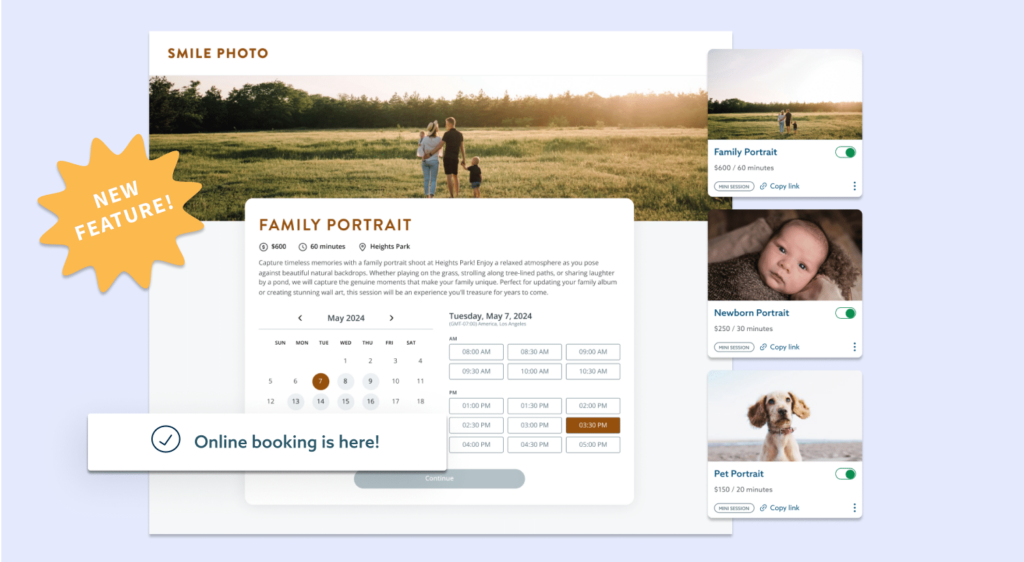
Craft smart policies and learn how to handle late clients with these easy email scripts, online client contracts, and communication tips.
7 tips for creating an on-time policy for your photography clients
There’s nothing more frustrating than clients who show up late for their photo session. There you are, set and ready to go, but your client is 10 minutes late… 30 minutes late… Now the light is changing and you have another session to prep for.
What do you do?
We’ll show you how to craft a policy that works for YOUR photography business.

Brittany Boote
#1: Brainstorm policy ideas for each client type
Make a list of the types of photography you offer: mini sessions, weddings, personal branding shoots, etc. What issues do you need to address for each of these genres?
For example, a 15-minute mini session will have different policy needs than a full session or an eight-hour wedding.

Brittany Boote
#2: Add your policies to your contracts
Hopefully you’re using a unique contract for each session type. You’ll find many contract templates in the ShootProof Marketplace, ready for you to add to your Contracts workspace.
If you need to modify your contract template, it’s best to get an attorney involved. They’ll make sure you have a reasonable and enforceable policy that is easy to understand.

Brittany Boote
#3: What makes a good on-time policy?
A legal policy is one thing. But you also need a policy that you feel good about. After all, you’re the one who will need to enforce it!
Here’s how other photographers have managed their own no-show, on-time, and rescheduling policies:

Brittany Boote
IDEA: Charge a late fee
A policy that says, “If you’re late, you owe me $1M,” is, of course, ridiculous. But reasonable, flat-rate late fees are common in many service industries.
If a client cancels with less than 24 hours’ notice, you likely already have a clause in your contract that allows you to keep their non-refundable retainer as a cancellation fee.
Late fee pros:
- incentivize clients to be on time
- get reimbursed for your wasted time
Late fee cons:
- now you have to get that client to pay the late fee (yuck!)
- even if the client does pay, they probably won’t feel great about it

Brittany Boote
IDEA: Use mandatory rescheduling
If your client is going to be more than, say, 15 minutes late for their appointment time, you may want to require them to reschedule.
Rescheduling pros:
- by rescheduling, you’ll be able to give your clients the full experience they paid for
- you’ll limit the time you’ve wasted
Rescheduling cons:
- if your client owes you a balance, that final payment may now be delayed
- now you’ve lost a time slot that could have been booked by someone else

Brittany Boote
IDEA: Charge for added time
This is a common solution for wedding photographers whose clients want them to stay an extra hour. It can also be used for portraits clients!
If a session was scheduled from 9:00am to 10:00am, but your client is 30 minutes late, you may offer to extend their photography until 10:30 if they wish to pay for that additional half-hour.
#ShootProofPRO Tip: Use your hourly rate (not including product) to correctly calculate the cost of any added time.

Brittany Boote
IDEA: Stick to your session start and end times
If a session is scheduled from 9:00am to 10:00am, but your client doesn’t show up until 9:30, it’s okay to still only shoot until 10:00am. That’s the time block they booked, and it’s the only time block you are bound to honor. Bottom line: your time is money!
End time pros:
- your next session won’t get delayed because the earlier clients were stuck in traffic
- no concerns about the sun getting too high/low and ruining your perfectly-planned light
End time cons:
- your late client may feel like they didn’t get what they paid for
- you may feel pressured to take the same number of photos in less time
#ShootProofPRO Tip: If your late client is upset that their session will be shorter, you may consider giving them a print or product credit for the “unused” portion of their session fee. Setting boundaries doesn’t mean you can’t make concessions when it feels right.

Brittany Boote
#4: Clearly communicate your policy during the booking process
Putting something in your contract doesn’t make it “true.” For the most seamless photography experience, you need your client’s buy-in. You need them to truly understand and agree that your policies are reasonable and worthy of their signature.
The best way to encourage people to respect your time is to clearly communicate your on-time, rescheduling, cancellation, and no-show client policies from the start.
Do a contract walk-through with every client before they sign. If you can’t do it by phone, a text or email like this is helpful:

Brittany Boote
Text or email script: Contract walk-through
Hello, lovely new client!
Here’s the link for your booking agreement and invoice. I’m thrilled to be working with you!
Please take note of these key contract clauses:
• Package Details
• Payment Schedule
• Cancellation Policy
• On-Time Policy
• Copyright
I would love to schedule a call with you to answer any questions!
— Your Photographer

Brittany Boote
#5: Remind your clients of your tardiness policies before their session
A couple of days before their session, send your clients a session reminder via text or email (whichever they prefer). It should say something like this:
Text or email script: Session reminder
Hello, awesome client!
I’m excited for our session together:
[LOCATION]
[DAY & DATE]
[START TIME & END TIME]
Please be sure to arrive 10-15 minutes early so we can begin on time. A late start will result in a shorter session, and neither of us wants that!
On the day of your session, you can call or text me any time at [CELL #], and I’ll respond promptly.
See you soon!
— Your Photographer

Brittany Boote
#6: Say it out loud—and set a timer
When your clients arrive late, verbally remind them, “We have 30 minutes left for photos, so let’s start having fun!” Then set an alarm on your phone to notify you five minutes before the session is scheduled to end.
When your alarm sounds, ask, “Any final requests?” and gently but firmly bring the session to a close.

Brittany Boote
#7: Uphold your policies with confidence
Do you feel nervous about having to enforce your policies? Don’t be!
Think of your business like a young plant. If you don’t take good care of it, it will cease to grow—and may not survive at all.
You alone are responsible for the health of your business. Take that job seriously, and your business will thrive!
Written by ANNE SIMONE | Photographs by BRITTANY BOOTE PHOTOGRAPHY


